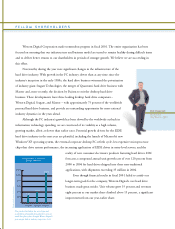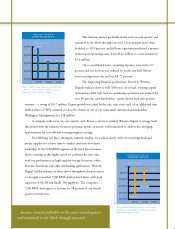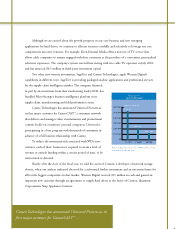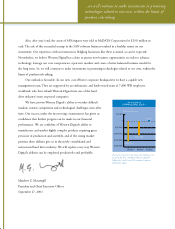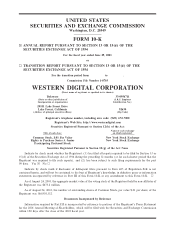Western Digital 2001 Annual Report Download - page 15
Download and view the complete annual report
Please find page 15 of the 2001 Western Digital annual report below. You can navigate through the pages in the report by either clicking on the pages listed below, or by using the keyword search tool below to find specific information within the annual report.drives. See Part II, Item 7, under the heading ""Risk factors related to the hard drive industry in which we
operate.''
Emerging Audio-visual Markets. Audio-visual content stored for entertainment has historically been
stored on removable media, such as compact disks (""CDs''), digital video disks (""DVDs''), and videotape.
These media have also been used to transport and deliver content. The emergence of broadband communica-
tions as a means of delivering digital content makes it unnecessary to use the removable media itself for
delivery. This allows hard drives to become the storage media for this digital, audio-visual content as it is
delivered through broadband communications. This has led to the use of hard drives in products for consumer
broadband communications networks, such as cable and satellite networks. Audio-visual applications such as
digital video recording devices represent a developing market opportunity for the Company's hard drive
technologies. Hard drive technology makes it possible to simultaneously record and play back content; to
pause and skip forward and backward during live broadcasts; and to rapidly access large amounts of
audio-visual content.
Because the market for audio-visual products has not yet developed, it is too early to project the likely
size and growth of such market. For further discussion of this product development eÅort, see Part II, Item 7,
under the heading ""Risk factors relating to Western Digital particularly.''
Products
The Company's WD Caviar» and WD Protege
TM
hard drive products are designed to serve the advanced
and value portions, respectively, of the desktop PC market, entry level server markets and game console
markets, and its WD Performer
TM
hard drive products are designed to serve the emerging audio-visual portion
of the hard drive market.
Desktop PC and Entry-Level Server Hard Drive Products. The WD Caviar and WD Protege families
currently consists of 1.0‰ high, 3.5-inch form factor products with capacities ranging from 8 GB to 100 GB
and rotation speeds of 5400 and 7200 rpm. In 1998 the Company introduced the Data Lifeguard
TM
feature, an
exclusive data reliability feature which is now implemented in all of the Company's hard drives. Data
Lifeguard protects end-user data by automatically detecting, isolating, and repairing possible problem areas on
the hard drive before data loss can occur. These products utilize the EIDE interface, providing high
performance while retaining ease of use and overall low cost of connection. The type of EIDE interface
currently used in substantially all of the Company's hard drives is ATA/100, which signiÑes an internal data
transfer rate of 100 megabytes per second, almost twice as fast as the previous generation of EIDE interface.
The Company also sells a line of hard drives and related adapters which are designed to accommodate an
interface known as ""1394/Firewire/i.Link'', for use primarily in connecting digital consumer electronic
devices, such as digital video camcorders.
The Western Digital product line generally leverages a common architecture or ""platform'' for various
products with diÅerent capacities to serve the diÅering market needs. This platform strategy results in
commonality of components across diÅerent products, which reduces exposure to changes in demand,
facilitates inventory management and allows the Company to achieve lower costs through economies of scale
purchasing. This platform strategy also enables computer manufacturer customers to leverage their qualiÑca-
tion eÅorts onto successive product models. The Company expects to continue to utilize this platform strategy
as it develops products for the emerging market for hard drives speciÑcally designed for audio-visual
applications, such as new digital video recording devices.
Audio-visual Hard Drive Products. The Company oÅers customized design capabilities and unique hard
drive technologies for consumer applications; however, where practical, the Company intends to leverage its
existing product line architectures for the various products for the audio-visual market. The Company is
currently oÅering the WD Performer
TM
hard drive product line designed for use in consumer audio-video
applications. It is also developing hard drives and products incorporating hard drive technology for consumer
electronics products including digital cable set-top boxes, satellite television boxes, audio-visual jukeboxes and
video game consoles.
5


